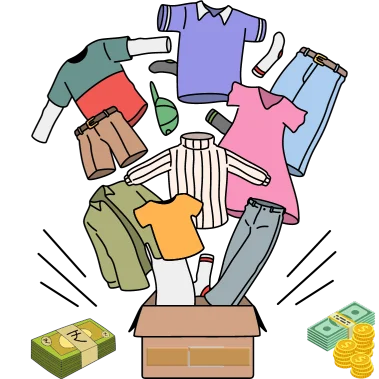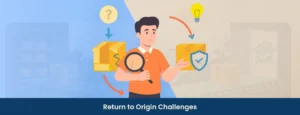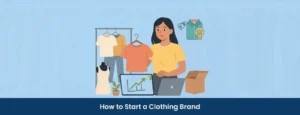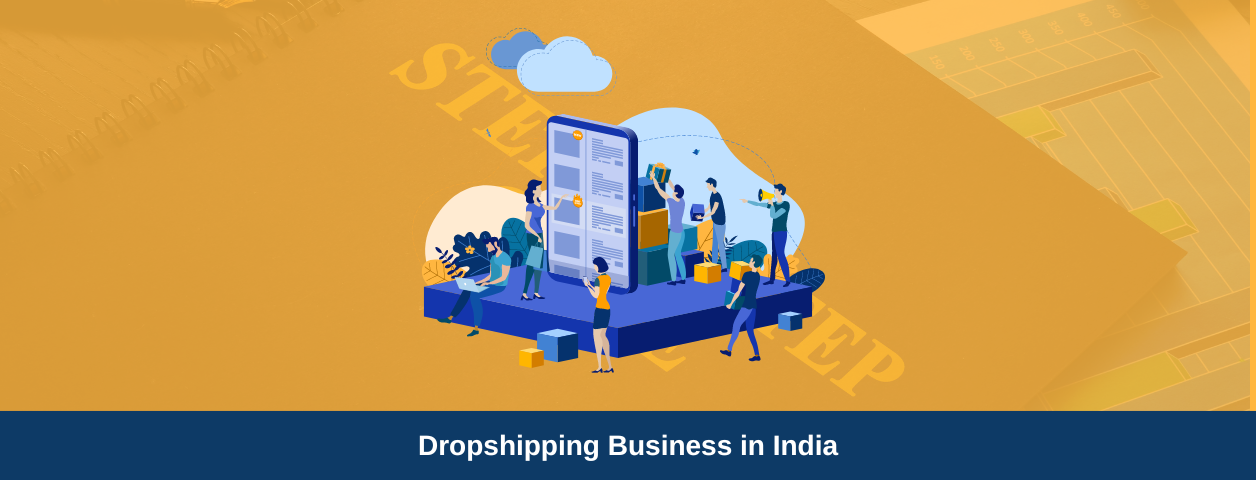In the world of online business, two models dominate the conversation for aspiring entrepreneurs – dropshipping and affiliate marketing. Both offer a low-cost entry, the flexibility to work from anywhere, and the potential to earn passive income. However, the way they operate, the skills they require, and the type of profits they generate are very different. While dropshipping lets you sell physical products without managing inventory, affiliate marketing allows you to earn commissions by promoting other people’s products. Choosing between the two isn’t just about profit potential, it’s about matching the model to your strengths, resources, and long-term goals.
Affiliate Marketing vs Dropshipping:
|
Feature
|
Dropshipping
|
Affiliate Marketing
|
|---|---|---|
|
How it Works
|
You sell products from your own store; a third-party supplier ships them directly to the customer.
|
You promote a merchant's products; you earn a commission for sales made through your referral link.
|
|
Earning Model
|
You earn the profit margin (your selling price minus the supplier's wholesale price).
|
You earn a fixed commission (a percentage of the sale) set by the merchant.
|
|
Your Role
|
You act as the retailer, managing your own store, processing orders, and handling payments.
|
You act as a promoter or advertiser, driving traffic to the merchant's website.
|
|
Responsibility
|
You are fully responsible for all customer support, returns, and order-related issues.
|
You have no responsibility for customer support, shipping, or returns; the merchant handles it all.
|
|
Pricing & Offers
|
You have full control to set your own product prices and create special offers.
|
You have no control over prices or offers; they are set by the merchant.
|
|
Long-Term Growth
|
High potential to grow into a standalone, independent e-commerce brand with a loyal customer base.
|
Growth depends on your content and traffic, but you will always remain dependent on the merchant's programs.
|
|
Branding & Control
|
Limited control. The store operates within the Roposo ecosystem and brand guidelines.
|
Full control over branding, website design, customer experience, and data.
|
|
Customer Relationship
|
You own the relationship and can market to customers directly to encourage repeat business.
|
The purchase is a one-time referral. The merchant owns the customer relationship.
|
|
Control Over Products
|
You have full control over which products you choose to list and sell in your store.
|
You can only promote the products and offers that are available in the merchant's affiliate program.
|
|
Customer Data
|
You own all customer data (emails, purchase history) and can use it for marketing.
|
You do not own or have access to any customer data.
|
|
Future Prospect
|
A dropshipping store has the potential to scale into a complete, independent brand that you own
|
Your success as an affiliate marketer always depends on the products, rules, and commissions set by the companies you promote.
|
|
Recurrency of sales
|
You own the customer relationship, making it possible to build a loyal base that provides repeat business.
|
Your role is typically limited to a one-time referral; you don't earn from any future purchases the customer makes.
|
What is Dropshipping?
Dropshipping is a retail business model where an online store sells products to customers without ever actually stocking the items itself. When a customer makes a purchase, the store owner buys the item from a third-party supplier (usually a wholesaler or manufacturer) who then ships the product directly to the customer.
In short, the seller acts as a middleman. You market and sell the products, but you never physically handle, store, or ship them.
Key Players in Dropshipping
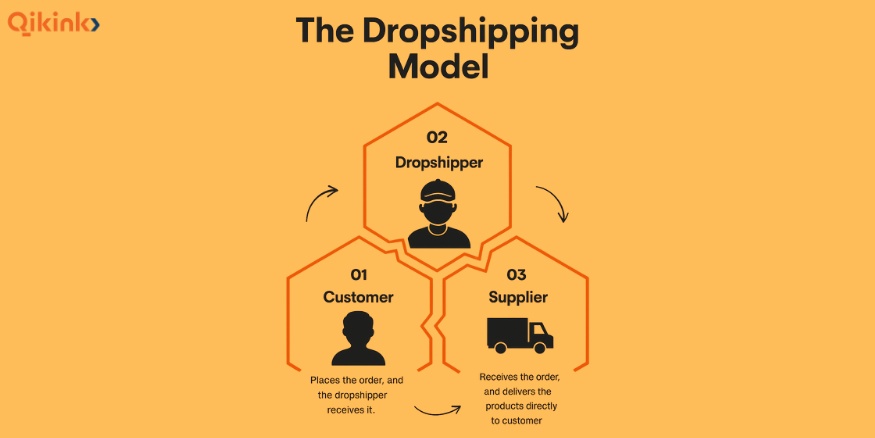
In any dropshipping transaction, there are three key players whose roles are distinct but interconnected:
- Customer: The person who visits your store, places an order, and only interacts with your brand, unaware that a third party ships the product.
- Retailer (You- The Seller): You run the online store, market products, set prices, handle customer support, and forward orders to the supplier.
- Supplier: A manufacturer, wholesaler, or fulfillment center that stores inventory, packs orders, and ships them directly to customers.
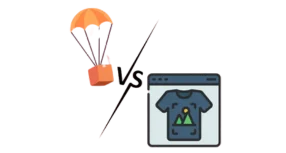
How Dropshipping Works:
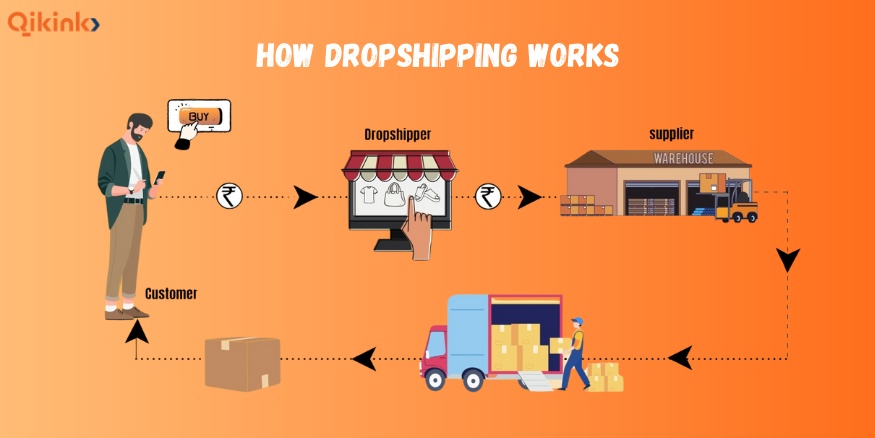
Here is the process broken down into six main steps:
- Find a Product & Supplier First, you research and choose a product, then partner with a right supplier who stocks it and agree on their wholesale price.
- Set Up Your Online Store Next, you build an online store (using platforms like Shopify, WooCommerce, or others) and list the supplier’s products for sale at your own retail price which includes the supplier’s cost plus your desired profit margin.
- A Customer Places an Order A customer visits your store and buys a product, paying you the full retail price directly.
- Forward the Order to the Supplier You then send the order details to your supplier and pay them their lower wholesale price for the item. Your profit is the difference between the two prices.
- The Supplier Ships the Product The supplier packages the product and ships with a seller brand name directly to the customer’s address.
- Handle Customer Communication Finally, you provide the customer with a tracking number and manage all customer service questions about the order.
Important Note: GST Registration for Dropshipping in India
Please be aware that having a GST (Goods and Services Tax) registration is mandatory to operate a dropshipping business in India.
While the general GST registration threshold for many businesses is a turnover above ₹20 lakhs, the law for e-commerce is stricter. According to the GST Act, anyone selling goods online through an e-commerce platform must register for GST, regardless of their annual turnover.
It is highly recommended to consult with a tax professional or Chartered Accountant (CA) to ensure your business is set up correctly and fully compliant before you begin selling.
Dropshipping Example:
Let’s imagine you want to sell a “Smart Coffee Mug.”
Your supplier’s price for the mug is ₹800.
You list the mug on your website for ₹1,500.
A customer in Mumbai buys the mug from your store and pays you ₹1,500.
You forward the order to your supplier and pay them ₹800.
The supplier ships the mug from their warehouse to the customer in Mumbai.
Your gross profit on the sale is ₹700 (₹1,500 – ₹800). This profit is then used to cover your business expenses like marketing, website fees, and payment processing fees.
The Flow of Money vs. The Flow of Goods
A simple way to understand dropshipping is to see that money and goods flow in different paths:
The Flow of Money: Customer → You (The Retailer) → The Supplier
The Flow of the Product: The Supplier → The Customer

How you earn money with dropshipping?
Earning money through dropshipping involves several key steps:
The foremost step in earning profits through dropshipping is identifying the right potential products for your online store.
Choose unique selling points and features that differentiate your products from the competition and attract your target audience’s attention.
Find a reliable dropshipping supplier for efficient order fulfillment.
Integrate with the best e-commerce platforms such as Shopify, WooCommerce, Amazon, and eBay, and set up your online store.
Add your products to the store and establish competitive pricing strategies and payment gateways.
Develop effective marketing strategies to promote your products, as good marketing can significantly enhance your brand visibility.
The remaining process, from order processing to shipping, is handled by the third-party supplier.
You pay the supplier for the product at a discounted price, while retaining the difference as profit.
Following these steps will help you earn profitable returns through dropshipping.
Dropshipping: Pros vs. Cons
|
Pros
|
Cons
|
|---|---|
|
Low Startup & Manpower Cost: Requires minimal initial investment and less staff as there is no physical inventory to manage.
|
Low Profit Margins & High Competition: Intense competition and supplier costs result in smaller profits per sale.
|
|
Easy to Test & Add Products: You can experiment with a wide variety of products and add new items to your store instantly without any financial risk.
|
Lack of Control Over Supply Chain: You have less control over product quality, inventory levels, and final delivery times.
|
|
Simplified Order Fulfillment: The supplier handles all the hassle of packing and shipping orders directly to the customer.
|
Limited Product Selection: Your product offerings are restricted to the inventory that is available from your chosen suppliers.
|
|
Location Independence: The business can be managed from anywhere in the world with a stable internet connection.
|
Full Responsibility for Issues: You must handle all customer complaints and support, even for supplier mistakes or shipping delays.
|
|
Easy to Launch & Scale: The business model is simple to set up, and as sales grow, the fulfillment workload is handled by your partners.
|
Poor Branding & Customer Experience: It is difficult to create a unique brand or control the customer's unboxing experience.
|
What is Affiliate Marketing?
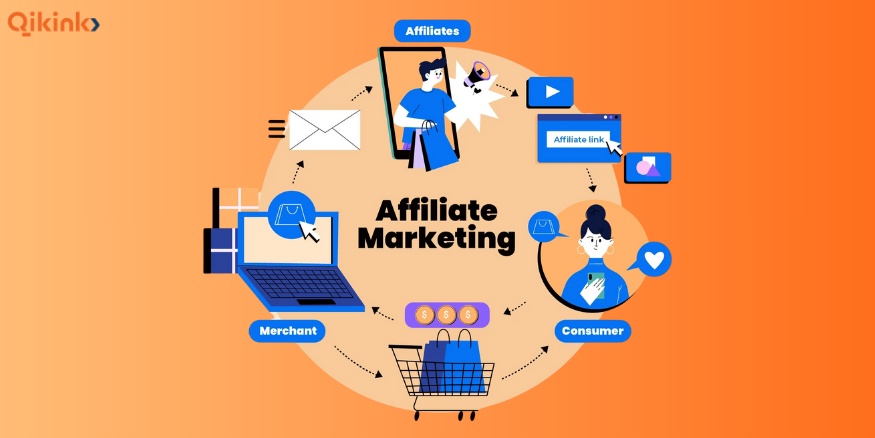
Affiliate marketing is a performance-based marketing strategy where an individual or company, known as an affiliate, earns a commission for promoting another company’s products or services. The affiliate simply finds a product they like, promotes it to others, and earns a piece of the profit for each sale that they generate.
In essence, you get paid to refer new customers to a business.
The Key Players Involved
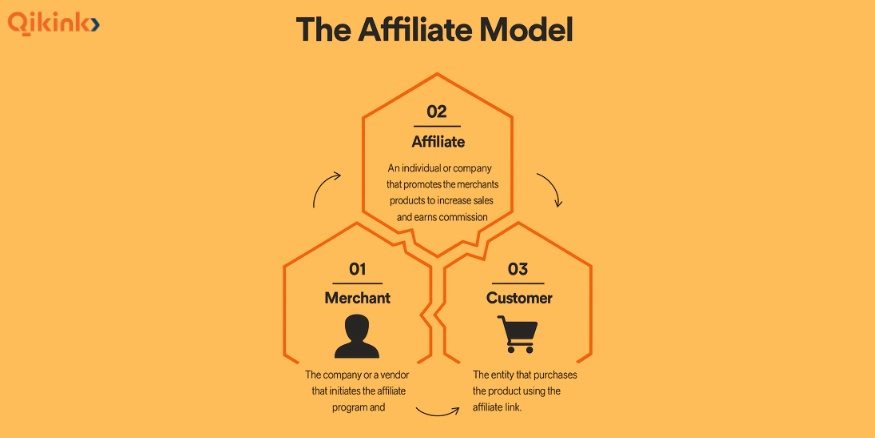
There are three main parties that make the affiliate marketing model work:
- The Merchant (also known as the Advertiser or Brand): The company that makes and sells the product or service, from big names like Amazon to small niche businesses. They run the affiliate program to attract more customers.
- The Affiliate (also known as the Publisher or Partner): You, the person or platform promoting the merchant’s products through blogs, videos, social media, or websites to earn a commission.
- The Customer: The end-user who sees the affiliate’s promotion, clicks their unique link, and makes a purchase on the merchant’s website.

How Affiliate Marketing Works:
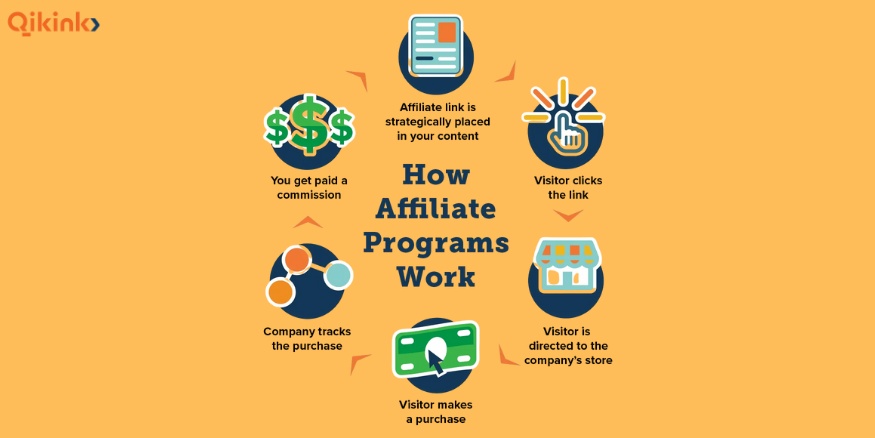
Affiliate marketing operates on a simple principle: you get paid for referring customers. The entire process is managed through a unique, trackable link that ensures you get credit for every sale you generate.
Here’s the breakdown:
- Join a Program Find a product you want to promote and sign up for its affiliate program (e.g., Amazon Associates, Flipkart which give you access to many brands at once)
- Get Your Unique Link The company gives you a special, trackable “affiliate link” that is unique to you. This “affiliate link” contains a unique tracking ID that tells the company that you were the one who sent the customer to their website.
- Promote the Link Share this link within your content, such as blog posts, YouTube videos, or social media updates.
- A Customer Clicks A customer clicks your link, which places a tracking cookie on their device to credit you for the referral.
- The Customer Buys The customer is taken to the company’s website and completes their purchase.
- You Earn a Commission After the sale is confirmed, you earn a commission (a percentage of the price), which is typically paid out to you monthly.
Affiliate Marketing Example:
Let’s imagine you are an affiliate marketer with a tech blog.
- You promote a pair of “Wireless Headphones” sold on Croma’s website for ₹4,000.
- Your affiliate commission rate from Croma for this product is 5%.
A reader sees your blog review, clicks your unique affiliate link, and buys the headphones directly from Croma’s website for ₹4,000.
- Croma processes the payment and ships the headphones from their warehouse to the customer.
- Because the customer used your link, Croma pays you a 5% commission for the referral.
Your gross earning on the sale is ₹200 (₹4,000 x 5%). This profit is earned simply for referring the customer, without handling any products or payments yourself.
The Flow of Money vs. The Flow of Goods
- The Flow of Money: Customer → Merchant (Croma) → You (The Affiliate)
- The Flow of the Product: Merchant (Croma) → Customer
How to Earn Money with Affiliate Marketing
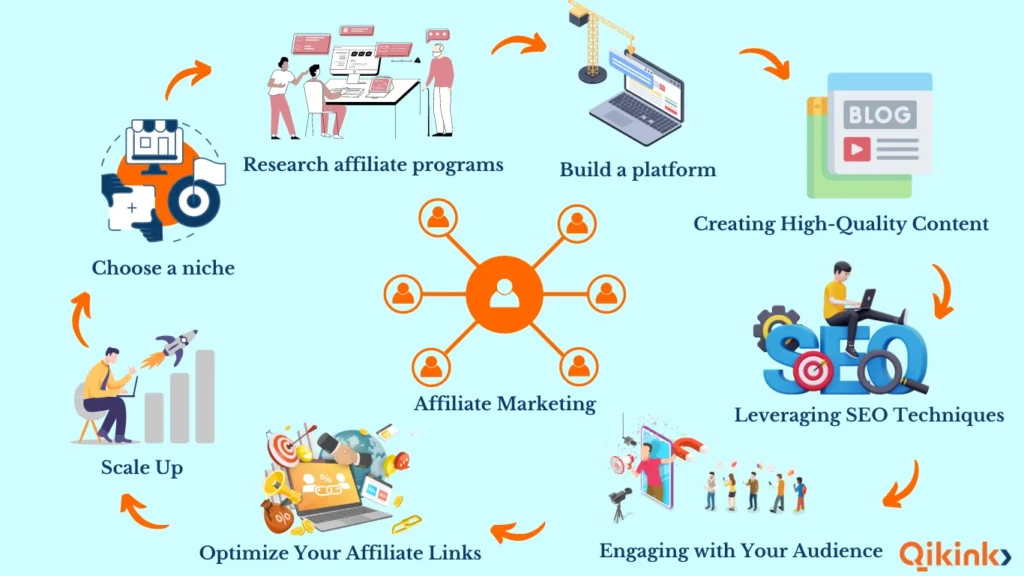
Affiliate marketing is a performance-based business model where you promote products or services and earn a commission for each sale or lead generated through your unique link. Here’s a step-by-step guide to making it work:
1. Choose Your Niche
Pick a topic or industry or dropshipping niche you’re passionate about and that has a clear demand for products or services. A focused niche helps you attract a targeted audience.
2. Find the Right Affiliate Programs
Research reputable affiliate programs that match your niche. Compare commission rates, cookie durations, payout terms, and the level of support provided.
3. Build Your Platform
Create a blog, website, YouTube channel, or social media presence to showcase affiliate products and connect with your audience.
4. Create High-Value Content
Produce informative, engaging, and helpful content that solves problems for your audience. Use blogs, videos, tutorials, and infographics to keep them interested.
5. Leverage SEO to Drive Traffic
Optimize your content for relevant keywords, improve website speed, and build backlinks. SEO ensures a steady flow of organic visitors, especially important for long-term income in India.
6. Engage With Your Audience
Respond to comments, messages, and questions. Building trust and relationships increases the chances of conversions.
7. Place Affiliate Links Strategically
Add affiliate links naturally within relevant content. Use banners, buttons, and text links without overwhelming readers. Include them in emails alongside valuable tips. Tools for link management help keep everything organized.
8. Track & Optimize Performance
Use Google Analytics and affiliate dashboards to monitor clicks, conversions, and earnings. Adjust strategies based on what’s working best.
9. Scale Your Efforts
Once you see consistent results, explore new niches, add more products, and automate parts of your process to grow your income.
Bottom line:
By consistently delivering value, building trust, and optimizing your strategy, affiliate marketing can become a sustainable source of commissions and passive income.
Pros vs. Cons of Affiliate Marketing
|
Pros
|
Cons
|
|---|---|
|
Low Cost & Low Risk: You don't need to create a product, manage inventory, or handle shipping.
|
Income is Not Guaranteed: It's purely commission-based. If you don't generate sales, you don't earn money.
|
|
Passive Income Potential: A single blog post or video can continue to earn you commissions long after it's published.
|
Requires Time & Effort: Building an audience that trusts your recommendations takes a significant amount of time and consistent effort.
|
|
High Flexibility: You can work from anywhere and choose to promote products that genuinely align with your interests.
|
No Control Over the Product: You don't control the product's quality, price, or the commission rates, which the merchant can change at any time.
|
|
No Customer Service: The merchant is responsible for all customer support, returns, and complaints.
|
High Competition: Popular niches are often saturated with other affiliates, making it difficult to stand out.
|
|
Easy to Get Started: The operational side is simple, allowing you to focus purely on content creation and marketing.
|
Delayed Payouts: You don't get paid instantly. Earnings are typically paid out monthly and only after you meet a minimum payment threshold.
|
Dropshipping vs Affiliate Marketing: Key factors compared
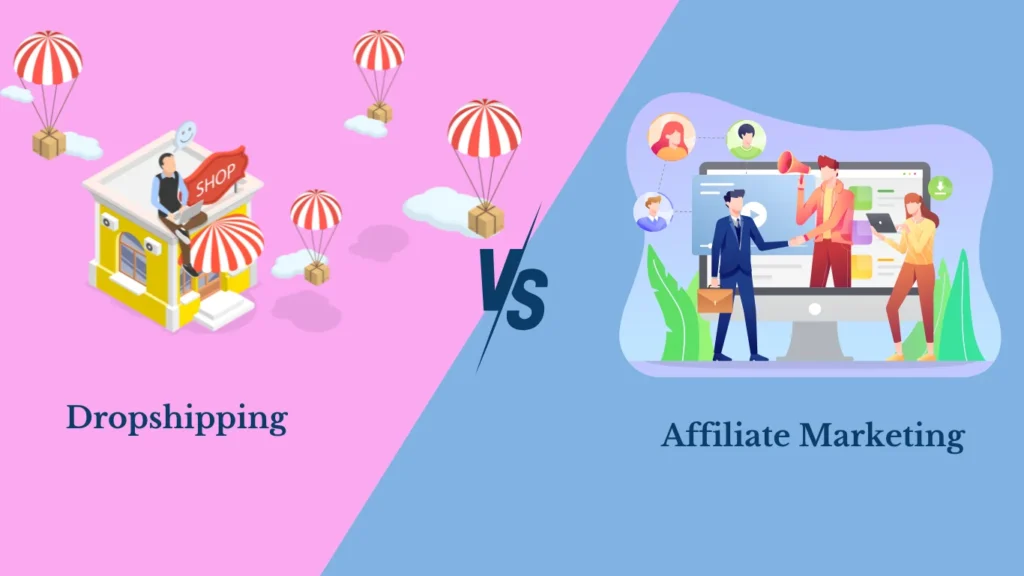
Dropshipping and affiliate marketing are both popular online business models that require low initial investment, but they cater to different skills and ambitions. Dropshipping involves creating your own online retail brand, while affiliate marketing focuses on earning commissions by promoting other companies’ products.
Here’s a clear comparison of the two.
Ease of Getting Started
Affiliate marketing generally has a lower barrier to entry and is quicker to launch. You can begin with minimal resources, such as a blog, social media profile, or email list, and start promoting products almost immediately.
Dropshipping also offers a straightforward path into e-commerce but requires more initial setup. You must research profitable products, find reliable suppliers, and build a complete online store using platforms like Shopify or WooCommerce before you can make your first sale.
Skills Required
While both models depend on digital marketing skills like SEO and social media advertising, their core skill requirements are different.
- Affiliate Marketing is best for content creators. Success is driven by your ability to write persuasive reviews, create engaging videos, and build an audience that trusts your recommendations.
- Dropshipping is better suited for business generalists. It requires a broader skillset that includes product research, supplier management, customer service, branding, and e-commerce operations.

How Much Does It Cost to Start?
One of the biggest perks of affiliate marketing is that it requires almost no investment in inventory, manufacturing, or shipping. You simply promote other companies’ products and earn a commission on sales, no product handling involved.
Similarly, dropshipping also offers low startup costs. You only purchase products after a customer places an order, so there’s no need to invest in stock upfront. The main expenses come from setting up your online store, marketing, and platform fees.
Below is a breakdown of typical startup costs for each model in India.
Cost to Start a Dropshipping Business in India
Dropshipping is budget-friendly to start, but you should plan for some essential expenses:
- E-commerce platform fee: ₹29 to a few thousand rupees per month, depending on your chosen platform.
- Dropshipping platform fee: Around ₹499/month on average, varying by provider.
- Product costs: The largest ongoing expense, you pay suppliers after customers place orders.
- Marketing & advertising: Organic marketing is free, but for paid ads, budget ₹1,000–₹2,000/month initially.
- Domain & website design: Some platforms include a free domain; otherwise, expect design costs starting from ₹5,000 (higher for custom features).
Recommended startup budget (excluding product cost): ₹10,000–₹25,000 for a smooth launch.
Cost to Start an Affiliate Marketing Business in India
Dropshipping is budget-friendly to start, but you should plan for some essential expenses:
- E-commerce platform fee: ₹29 to a few thousand rupees per month, depending on your chosen platform.
- Dropshipping platform fee: Around ₹499/month on average, varying by provider.
- Product costs: The largest ongoing expense, you pay suppliers after customers place orders.
- Marketing & advertising: Organic marketing is free, but for paid ads, budget ₹1,000–₹2,000/month initially.
- Domain & website design: Some platforms include a free domain; otherwise, expect design costs starting from ₹5,000 (higher for custom features).
Recommended startup budget: As low as ₹1,500/year for a basic website, scaling up if you invest in paid promotions.
Which is More Profitable?
Both dropshipping and affiliate marketing offer real earning potential, but they work in different ways. Dropshipping involves selling products directly to customers and keeping the profit margin, while affiliate marketing pays you a commission for promoting other people’s products.
Dropshipping Profitability
According to Grand View Research, the dropshipping market in India is expected to reach a projected revenue of US$ 102,393.2 million by 2030. A compound annual growth rate of 23.4% is expected of India dropshipping market from 2025 to 2030. As online shopping continues to rise, dropshippers can tap into a vast customer base.
- High Demand: The shift toward eCommerce means a bigger audience for dropshipping businesses.
- Product Variety: Access to a wide range of items allows competitive pricing and market adaptability.
- Scalability: Smart product selection and strong marketing can turn a small operation into a thriving brand.
- Low Barrier to Entry: Especially in India, dropshipping offers newcomers a low-investment way to start a business.
The key to success lies in curating quality products, building a professional online store, and delivering great customer experiences.

Affiliate Marketing Profitability
Affiliate marketing has been a proven revenue stream for years, with minimal startup costs and huge scalability potential.
- E-commerce Growth: The worldwide rise in online shopping creates more opportunities for affiliates to promote products.
- Endless Niches: From fashion to software, there’s a niche for every interest and audience.
- Simple Operations: You don’t need to create or store products, focus on content creation and promotion.
- Performance-Based Earnings: Businesses pay only for actual sales or leads, making this a sustainable and low-risk model for advertisers.
- Global Reach: You can market products to an international audience without geographical limits.
In short, dropshipping offers greater control and potentially higher profit margins per sale, while affiliate marketing provides lower overhead and the ability to earn passively once content is in place.
Which Has the Lower Risk?
When it comes to risk, dropshipping generally offers more security than affiliate marketing. In dropshipping, you only pay for products after a customer places an order, which greatly reduces upfront financial risk. Since you purchase items at wholesale prices and set your own retail prices, profit margins can be higher. Cash flow is also more predictable, as payments from customers are received immediately. Additionally, dropshipping eliminates the need for inventory storage or warehouse costs, allowing you to offer competitive prices with minimal investment.
In contrast, affiliate marketing comes with risks that are often outside your control. Your earnings depend on the merchant’s product quality, commission rates, and program stability. You have no say in pricing, and commission rates can be relatively low. Programs can be terminated without warning, and reputational harm may occur if the merchant engages in unethical or fraudulent practices. Earnings can also take a hit if affiliate links are removed, changed, or compromised due to hacking.
Dropshipping vs. Affiliate Marketing: Which Is Best for You?

Choosing between dropshipping and affiliate marketing comes down to your personal goals and priorities. Do you want to build and run an online store, or would you prefer to earn money by creating content and promoting products? Each path is suited for a different type of entrepreneur.
Here’s a breakdown of who each model is best for.
Dropshipping is the Better Choice If…
- You Want to Build Your Own Brand: Your primary goal is to create a unique business with its own brand identity, from the website design to marketing campaigns.
- You Seek Higher Profit Margins: You want full control over product pricing to maximize your potential revenue on every sale.
- You Value Total Business Control: You prefer managing all aspects of your operation, including curating the products you sell and how they are presented.
- You Enjoy Customer Interaction: You are prepared to handle all customer service, including inquiries and returns, seeing it as a chance to build lasting relationships.
In short: Choose dropshipping if you are an aspiring entrepreneur who wants to build and control a complete e-commerce business.
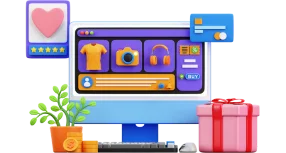
Affiliate Marketing is the Better Choice If…
- You Are a Passionate Content Creator: Your strength lies in creating engaging content like blog posts or videos about a niche you love.
- You Want a Low-Maintenance Business: You prefer a “hands-off” model that generates passive income without the daily tasks of managing inventory, shipping, or customer support.
- You Are Starting on a Tight Budget: You need the lowest possible startup cost and want to minimize all upfront financial expenses.
- You Want to Explore a Variety of Niches: You enjoy the flexibility of promoting different products across various interests without being tied to a single store’s inventory.
In short: Choose affiliate marketing if you are a content creator looking to monetize your audience with minimal operational responsibility.
Combining Dropshipping with Affiliate marketing
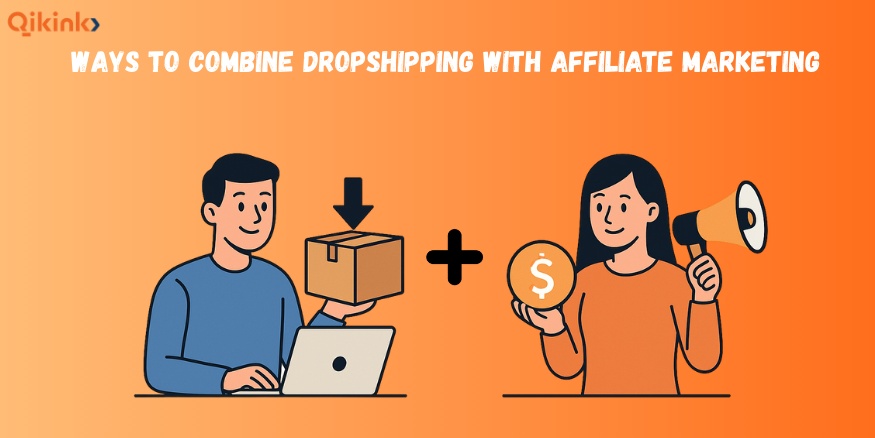
Think of it like this:
- Dropshipping: You have your own online store, but a supplier handles packing and shipping for you. You are the store owner.
- Affiliate Marketing: You get paid a commission to advertise someone else’s products. You are the advertiser.
You can mix these two ideas to make more money online. Here are the two main ways to do it.
Method 1: Get Others to Promote Your Store
In this method, you focus on your dropshipping store and have other people act as your affiliates.
- What you do: You pay people (like bloggers or influencers) a commission for every customer they send to your store who makes a purchase.
- How it works: You use an app on your store (like Shopify) to create special tracking links for your affiliates. When someone clicks their link and buys something, you pay the affiliate a percentage of the sale.
- Bottom line: You get more sales for your store without spending money on ads upfront.
Trying to figure out how Etsy selling works?

Method 2: Promote Other Products on Your Store
With this method, you sell your dropshipping products but also feature affiliate links for other items you don’t sell.
- What you do: You earn a commission by linking to other companies’ products from your store’s blog or product pages.
- How it works: Imagine you dropship coffee mugs. You could write a blog post titled “The Best Coffee Beans of 2025” and include affiliate links to buy those beans on another website, like Amazon. If your visitors click that link and buy the beans, Amazon pays you a commission.
- Bottom line: You make extra money on products you don’t have to manage or ship.
By combining these methods, you build your own brand through dropshipping while creating extra income streams through affiliate marketing.
How to Launch Your E-commerce Brand with Qikink
Starting an online business in India can seem daunting, with challenges like high investment, inventory management, and shipping logistics. Qikink eliminates these barriers with its powerful Print-on-Demand Dropshipping model, allowing anyone to launch a professional e-commerce brand with zero upfront cost.
Here’s how Qikink helps you build your business from the ground up.
1. Launch Your Business with Zero Financial Risk

The biggest hurdle for any new entrepreneur is cost. Qikink removes this completely.
- Absolutely Free to Use: Qikink’s platform is free for a lifetime. There are no setup charges, monthly subscriptions, or hidden fees.
- No Initial Investment: You don’t need to purchase any inventory. With the print-on-demand model, you only pay the wholesale price for a product after a customer has already placed and paid for an order in your store. This creates a risk-free business model perfect for beginners.
2. Create a Unique Brand with a Diverse Product Catalog
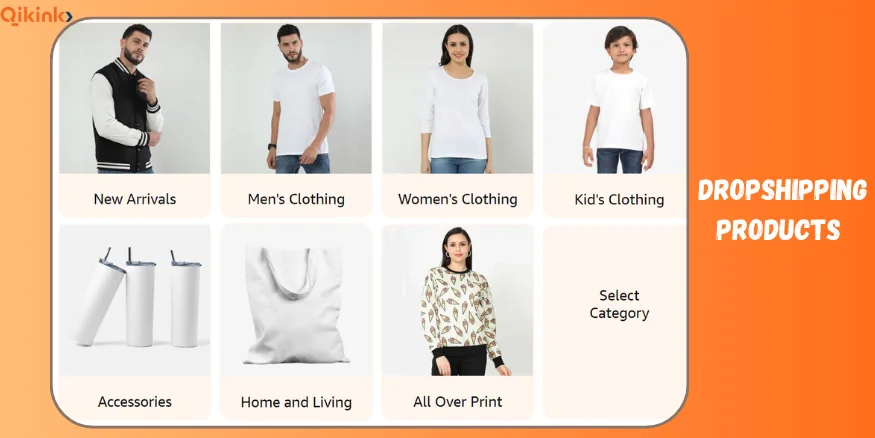
Building a memorable brand is key to success. Qikink provides the tools to both customize your products and your brand identity.
- Wide Range of Products: Instantly access a massive print-on-demand catalog with 200+ products. You can sell everything from apparel (t-shirts, hoodies, crop tops) and accessories (phone cases, mugs, tote bags) to home goods (posters, canvas prints).
- Free Custom Branding: Make every order your own. Qikink offers free custom branding services, allowing you to add your logo to shipping neck labels and include personalized thank-you notes or brand stickers, hand tags in your packages. This ensures your customers have a professional and satisfying unboxing experience.

3. Automate Your Operations from Order to Delivery
Focus on growing your business, not on managing logistics. Qikink’s platform automates the entire order fulfillment process.
- Effortless Inventory Management: Since products are printed on-demand, you never have to worry about managing stock, unsold items, or replenishing inventory. Qikink handles it all.
- Seamless E-commerce Integration: Easily connect your Qikink account with major platforms like Shopify and WooCommerce. When a customer places an order on your site, it’s automatically sent to Qikink for printing and fulfillment.
- All-India Shipping Network: Qikink takes care of packing and shipping your products to customers anywhere in India, using reliable courier partners for timely delivery.
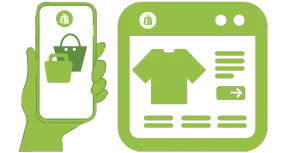
4. Partner with a Trusted Indian Dropshipping Leader
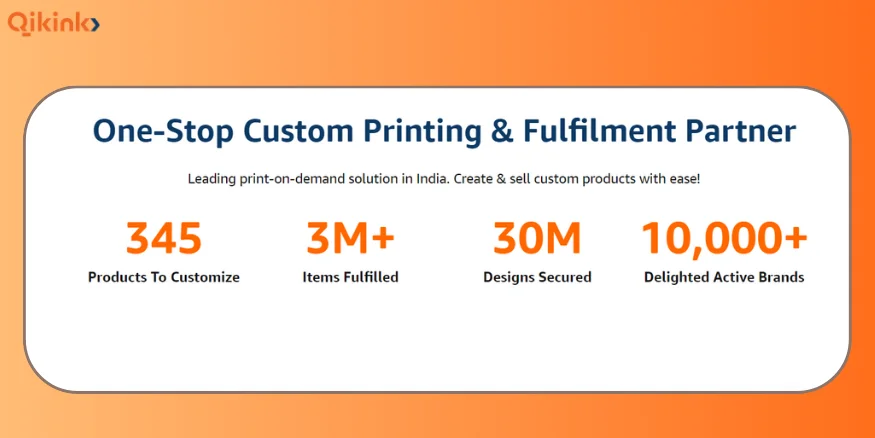
When you build your business with Qikink, you are partnering with an established and reliable leader in the Indian print-on-demand industry.
- Proven Track Record: Qikink is trusted by over 10,000 active online brands every month and has successfully fulfilled more than 3 million products across India.
- Competitive Pricing for Higher Profits: Qikink offers wholesale pricing that allows you to set competitive retail prices and still achieve healthy profit margins on every sale.
- Quality You Can Trust: Using advanced printing technologies like DTG (Direct-to-Garment), Qikink ensures every product is high-quality, with vibrant colours and durable prints that will satisfy your customers.
Conclusion
Both dropshipping and affiliate marketing can be profitable, but the best choice depends on your goals.
If you want more control over pricing, branding, and customer experience, and are ready to handle order fulfillment and marketing, dropshipping may be the better fit.
If you prefer a low-cost, low-maintenance option focused on content creation and passive income, affiliate marketing is a great choice.
In the end, success in either model depends on choosing the right niche, marketing effectively, and staying consistent.
Read More
- How dropshipping works for your online store?
- Automated Dropshipping: Best Tools & Software to scale in 2025
- 10 Profitable dropshipping business ideas to try
- Shopify Dropshipping Guide: How to dropship & make a profit
- AI Tools for Dropshipping: How to start and scale guide
- 200+ Best Dropshipping products to sell online
Frequently Asked Questions
Which business model requires less investment?
Affiliate marketing is the more budget-friendly option, demanding little to no initial investment as you aren’t managing inventory. Dropshipping, on the other hand, requires a small budget to build your online store and advertise products.
Which model gives higher profit margins?
You typically see higher profit margins with dropshipping because you have full control over the product’s retail price. Affiliate marketing margins are generally lower, as you only earn a pre-determined commission percentage that is set by the merchant.
Do I need to manage customer service in both models?
Yes, with dropshipping, you are the front line for all customer service, including handling inquiries, returns, and any support issues. In affiliate marketing, you are not responsible for customer service, as all support is managed by the product’s original seller.
Can I do both dropshipping and affiliate marketing together?
Absolutely. Combining these models is a powerful strategy to diversify your income. You can operate a dropshipping store for your core products while promoting complementary items through affiliate links to earn extra commission-based revenue.



